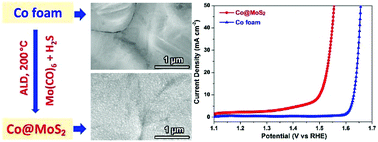Atomic-layer-deposited ultrafine MoS2 nanocrystals on cobalt foam for efficient and stable electrochemical oxygen evolution†
Abstract
Ultrafine molybdenum sulfide (MoS2) nanocrystals are grown on a porous cobalt (Co) foam current collector by atomic layer deposition (ALD) using molybdenum hexacarbonyl and hydrogen sulfide as precursors. When used to catalyze the oxygen evolution reaction (OER), the optimal Co@MoS2 electrode, even with a MoS2 loading as small as 0.06 mg cm−2, exhibits a large cathodic shift of ca. 200 mV in the onset potential (the potential at which the current density is 5 mA cm−2), a low overpotential of only 270 mV to attain an anodic current density of 10 mA cm−2, much smaller charge transfer resistance and substantially improved long-term stability at both low and high current densities, with respect to the bare Co foam electrode, showing substantial promise for use as an efficient, low-cost and durable anode in water electrolyzers.



 Please wait while we load your content...
Please wait while we load your content...